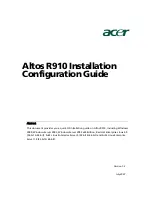
Running the Oracle HTTP Server on OpenVMS
D-24
Oracle9
i
Installation Guide Release 2 (9.2.0.2) for HP Alpha OpenVMS
To avoid confusion, always use the appropriate concealed logical name to specify
the file that you want to edit
.
For example, to edit a clusterwide version of
HTTPD.CONF,
refer to:
$ EDIT APACHE$COMMON:[CONF]HTTPD.CONF
If you referred to:
$ EDIT APACHE$ROOT:[CONF]HTTPD.CONF
then the server would open the clusterwide file but save it as a system-specific
version. The latest version of
HTTPD.CONF
would then be visible only to the
individual node on which it was saved.
Within
HTTPD.CONF
itself, you should make this distinction whenever you refer to
a path or to a file location
.
This improves performance and ensures that the server
will return a complete directory listing
.
For example, you should specify
APACHE$COMMON
or
APACHE$SPECIFIC
(instead of
APACHE$ROOT
) with Directory
directives.
The following extract, from the
HTTPD.CONF
file, refers to
APACHE$COMMON
because the content for the default web page is in the clusterwide directories.
DocumentRoot "/apache$common/htdocs"
...
<Directory "/apache$common/htdocs">
Options Indexes FollowSymLinks Multiviews
AllowOverride None
Order allow,deny
Allow from all
</Directory>
If there were content for one specific node in a cluster, the
APACHE$SPECIFIC
logical name would be used.
Mixed-Architecture Cluster
In a mixed-architecture cluster, do not use a cluster alias IP address with the Oracle
HTTP Server
.
Because the VAX systems will not have the Oracle HTTP Server
running, they will not be able to service HTTP requests.
Common Gateway Interface (CGI)
Common Gateway Interface (CGI) programs execute within the DCL shell on the
Oracle HTTP Server for OpenVMS
.
Please note the following OpenVMS specific
information.
















































